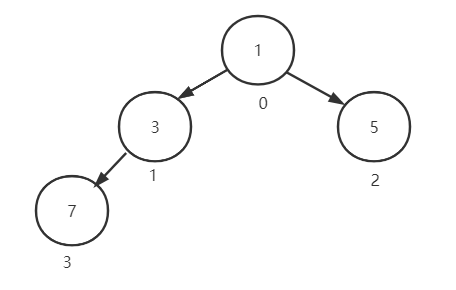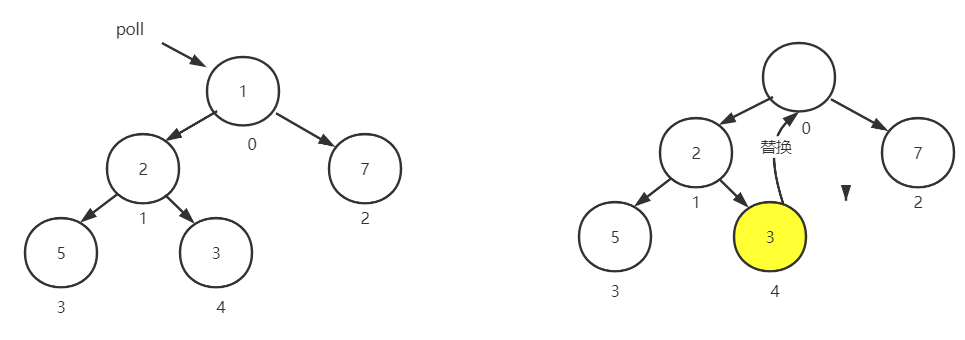DelayQueue是基于java中一个非常牛逼的队列PriorityQueue(优先队列),PriorityQueue是java1.5新加入的,当我看到Doug Lea大神的署名之后,我就知道这个队列不简单,那我们先来看一下他的源码吧:
作为一个队列来说,最基础的就是新增和查询,首先我们看下入队的逻辑:
1.入队
PriorityQueue提供了offer方法新增元素(add方法其实也是offer实现的),我们直接看下源码:
public boolean offer(E e) { if (e == null) throw new NullPointerException(); modCount++; int i = size; if (i >= queue.length) grow(i + 1); size = i + 1; if (i == 0) queue[0] = e; else siftUp(i, e); return true; }
offer方法首先判断是否需要扩容,若需要则走grow方法:
private void grow(int minCapacity) { int oldCapacity = queue.length; // Double size if small; else grow by 50% int newCapacity = oldCapacity + ((oldCapacity < 64) ? (oldCapacity + 2) : (oldCapacity >> 1)); // overflow-conscious code if (newCapacity - MAX_ARRAY_SIZE > 0) newCapacity = hugeCapacity(minCapacity); queue = Arrays.copyOf(queue, newCapacity); }
当长度小于64,扩容一倍+2,否则扩容50%。
再往下看若队列中没有元素,直接复制下标为0的元素,否则调用siftUp方法:
private void siftUp(int k, E x) { if (comparator != null) siftUpUsingComparator(k, x); else siftUpComparable(k, x); }
俩方法差不多一个,具体可搜compare和compareTo的区别如:https://blog.csdn.net/fly910905/article/details/81670353,我们直接看siftUpComparable方法:
private void siftUpComparable(int k, E x) { Comparable<? super E> key = (Comparable<? super E>) x; while (k > 0) { int parent = (k - 1) >>> 1; Object e = queue[parent]; if (key.compareTo((E) e) >= 0) break; queue[k] = e; k = parent; } queue[k] = key; }



结合上图和代码可以看出每个节点新增时,首先会根据节点下标计算出当前新节点应该属于的节点的父节点,比较当小于父节点则交换,无限循环,知道不存在父节点或者当前节点大于父节点的值,这样可以保证每个节点都比起子节点要小。
2.出队
入队的时候基本都差不多,但出队却有好几种,我们首先看peek方法:
public E peek() { final ReentrantLock lock = this.lock; lock.lock(); try { return q.peek(); } finally { lock.unlock(); } }
public E peek() { return (size == 0) ? null : (E) queue[0]; }
代码简洁明了,就是查询出第一个,这只能算查询,算不上出队,我觉得应该叫点名。
再看poll方法:
public E poll() { final ReentrantLock lock = this.lock; lock.lock(); try { E first = q.peek(); //取第一个节点 if (first == null || first.getDelay(NANOSECONDS) > 0) //节点为空或者首节点未到延时时间直接返回null return null; else return q.poll(); //PriorityQueue取节点逻辑 } finally { lock.unlock(); } }
再看PriorityQueue.poll方法:
public E poll() { if (size == 0) return null; int s = --size; modCount++; E result = (E) queue[0]; E x = (E) queue[s]; queue[s] = null; if (s != 0) siftDown(0, x); return result; }
首先取出第一个节点,然后将最后一个节点放替换首节点,并与子节点对比找出最小的并替换直到当前节点为最小为止,具体替换流程见siftDown代码:
private void siftDown(int k, E x) { if (comparator != null) siftDownUsingComparator(k, x); else siftDownComparable(k, x); }
private void siftDownComparable(int k, E x) { Comparable<? super E> key = (Comparable<? super E>)x; int half = size >>> 1; // loop while a non-leaf while (k < half) { int child = (k << 1) + 1; // assume left child is least 拿到左子节点下标 Object c = queue[child]; int right = child + 1; //右子节点下标 if (right < size && ((Comparable<? super E>) c).compareTo((E) queue[right]) > 0) c = queue[child = right]; //取出左右节点较小的 if (key.compareTo((E) c) <= 0) //当前节点比子节点小,结束流程 break; queue[k] = c; //替换子节点至父节点 k = child; } queue[k] = key; }
这个代码看起来稍微复杂点,会首先拿到左子节点和右子节点,对比取出较小的节点后与当前节点对比,将小的放在父节点位置,其实这里也是保证替换后的节点依然保持每个父节点最小,符合小顶堆。具体流程如下图所示:


我们最后看下take方法的实现:
public E take() throws InterruptedException { final ReentrantLock lock = this.lock; lock.lockInterruptibly(); try { for (;;) { E first = q.peek(); //取出第一个节点 if (first == null) //首节点为空说明队列为空,await等待 available.await(); else { //说明队列中有节点 long delay = first.getDelay(NANOSECONDS); //获取首节点延时时间 if (delay <= 0) //延时时间到期,直接取 return q.poll(); first = null; // don't retain ref while waiting if (leader != null) //说明当前有其他线程在操作(一般是其他线程在await) available.await(); else { //这里设置操作线程为自己,并等待延时时间时长 Thread thisThread = Thread.currentThread(); leader = thisThread; try { available.awaitNanos(delay); } finally { if (leader == thisThread) leader = null; } } } } } finally { if (leader == null && q.peek() != null) available.signal(); lock.unlock(); } }
这个实现一看就是阻塞式等待,取不到不罢休系列。
总结:
这篇写的还是比较简单的,大体介绍了DelayQueue的实现,也从底层了解了小顶堆PriorityQueue的实现,算是补充了之前对延时队列的具体实现,这篇主要是通过一个小顶堆的实现,保证每次取得值都是最小的,而又不用像数组那样每次插入都要重新排序,这里只要排序一部分就可以,也保证了性能,而DelayQueue中,加入了ReentrantLock保证了多线程的线程安全,同时加入Condition实现了延时阻塞式存取的机制,jdk的代码还是牛,这里其实就是我之前写锁的时候介绍的等待通知模式的一种实现,结合起来看还是有一些收获的。